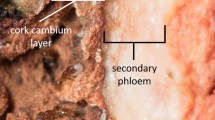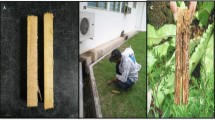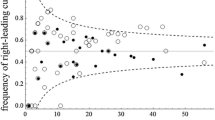Abstract
The Southeast Asian nasute termite Longipeditermes longipes forages on the open ground on leaf litter. Its monomorphic workers carry back food balls in their mandibles while dimorphic soldiers defensively surround the marching columns and the foraging patches. When mechanically disturbed, workers hide under the litter, whereas antennating soldiers face as closely as possible the source of disturbance. Foragers prefer the lower, nitrogen-rich layer of the litter. Soldier behavior and column organization (returning workers in the center lanes, outgoing workers in the two flanking lanes) are similar to those in the related genera Hospitalitermes and Lacessititermes, which, however, tend to forage above ground.
Similar content being viewed by others
REFERENCES
Belcher, R., and Godbert, A. L. (1954). Semimicro Organic Analysis, Longmans Green, London.
Collins, N. M. (1979). Observations on the foraging activity of Hospitalitermes umbrinus (Haviland), (Isoptera: Termitidae) in the Gunong Mulu National Park, Sarawak, Ecol. Entomol. 4: 231–238.
Escherich, K. (1911). Termitenleben auf Ceylon, Fischer, Jena, pp. 98–121.
Grant, J. (1951). Quantitative Organic Microanalysis, Based on the Method of F. Pregl, J. & A. Churchill, London.
Higashi, M., Abe, T., and Burns, T. P. (1992). Carbon-nitrogen balance and termite ecology. Proc. R. Soc. Lond. B 249: 303–308.
Jander, R., and Daumer, K. (1974). Guide-line and gravity orientation of blind termites foraging in the open (Termitidae: Macrotermes, Hospitalitermes). Insectes Soc. 21: 45–69.
Jones, D. T., and Gathorne-Hardy, F. (1995). Foraging activity of the processional termite Hospitalitermes hospitalis (Termitidae: Nasutitermitinae) in the rain forest of Brunei, north-west Borneo. Insectes Soc. 42: 359–369.
Kalshoven, L. G. E. (1958). Observations on the black termites, Hospitalitermes spp., of Jawa and Sumatra. Insectes Soc. 5: 9–30.
LaFage, J. P., and Nutting, W. L. (1978). Nutrient dynamics of termites. In Brian, M. Y. (ed.), Production Ecology of Ants and Termites, Cambridge University Press, London, pp. 165–232.
Matsumoto, T. (1976). The role of termites in an equatorial rain forest ecosystem of west Malaysia. I. Population density, biomass, carbon, nitrogen and calorific content and respiration rate. Oecologia 22: 153–178.
Miura, T., and Matsumoto, T. (1995). Worker polymorphism and division of labor in the foraging behavior of the black marching termite Hospitalitermes medioflavus, on Borneo Island. Naturwissenschaften 82: 564–567.
Miura, T., and Matsumoto, T. (1997). Diet and nest material of the processional termite Hospitalitermes, and cohabitation of Termes (Isoptera, Termitidae) on Boreno island. Insectes Soc. 44 (in press).
Miura, T., and Matsumoto, T. (1998). Foraging organization of the open-air processional lichenfeeding termite Hospitalitermes (Isoptera, Termitidae) in Borneo. Insectes Soc. 45 (in press).
Noirot, C. (1969). Formation of castes in the higher termites. In Krishna, K., and Weesner, F. M. (eds.), Biology of Termites, Academic Press, New York, pp. 311–350.
Noirot, C. (1992). From wood-to humus-feeding: An important trend in termite evolution. In Billen, J. (ed.), Biology and Evolution of Social Insects, Leuven University Press, Leuven, pp. 107–119.
Roonwal, M. L. (1970). Termites of the oriental region. In Krishna, K., and Weesner, F. M. (eds.), Biology of Termites, Academic Press, New York, pp. 315–391.
Sands, W. A. (1961). Foraging behaviour and feeding habits in five species of Trinervitermes in West Africa. Entomol. Exp. Appl. 4: 277–288.
Snyder, T. E. (1925). New termites and hitherto unknown castes from the Canal Zone, Panama. J. Agr. Res. 29: 179–193.
Sugio, K. (1995). Trunk trail foraging of the fungus-growing termite Macrotermes carbonarius (Hagen) in southeastern Thailand. Tropics 4: 211–222.
Thapa, R. S. (1982). Termites of Sabah, Sabah Forest Record No. 12.
Tho, Y. P. (1992). Termites of Peninsular Malaysia, Malayan Forest Records No. 36, Forest Research Institute, Malaysia.
Watson, J. A. L., and McMahan, E. A. (1978). Polyethism in the Australian harvester termite Drepanotermes (Isoptera, Termitinae). Insectes Soc. 25: 53–62.
Wood, T. G. (1978). Food and feeding habits of termites. In Brian, M. Y. (ed.), Production Ecology of Ants and Termites, Cambridge University Press, London, pp. 55–80.
Zar, J. H. (1984). Biostatistical Analysis, 2nd ed., Prentice-Hall, Englewood Cliffs, NJ.
Author information
Authors and Affiliations
Rights and permissions
About this article
Cite this article
Miura, T., Matsumoto, T. Open-Air Litter Foraging in the Nasute Termite Longipeditermes longipes (Isoptera: Termitidae). Journal of Insect Behavior 11, 179–189 (1998). https://doi.org/10.1023/A:1021039722402
Issue Date:
DOI: https://doi.org/10.1023/A:1021039722402




